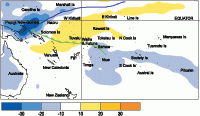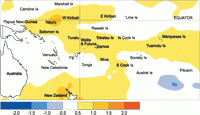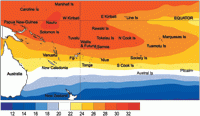Climate developments in September 2005

The South Pacific Convergence Zone (SPCZ) extended from the region northeast of Papua New Guinea and towards Samoa and Niue. A large area of enhanced convection affected the northwest Pacific, extending south towards Papua New Guinea and the Solomon Islands, and northeast to merge with the Inter-tropical Convergence Zone (ITCZ) north of the Equator. Slightly enhanced convection affected the region from Samoa east to the Society Islands of French Polynesia, and across to Pitcairn Island, including Niue and the Southern Cook Islands. Weakly suppressed convection existed over the regions between Vanuatu and Eastern Kiribati, including Tuvalu and the Northern Cook Islands.
Rainfall was more than 200% of average in Niue, and at least 125% of average in parts of Fiji, Tonga, and the Society Islands of French Polynesia. Torrential rainfall occurred in Fiji’s Central division during the last week of September, leading to flooding in parts of Suva, Nausori and Tailevu. A large number of villages were evacuated and there was one fatality. Nausori Airport recorded 187 mm of rain on the 28th.
The months rainfall was less than 75% of average in the Austral Islands of French Polynesia, and less than 50% of normal in much of New Caledonia.
Mean air temperatures were above average throughout much of the Southwest Pacific.
Tropical Southwest Pacific mean sea-level pressures were below average within about 15° north and south of the Equator, from about the Date Line east towards South America, and above average at 30° south from New Zealand to southern French Polynesia. Equatorial surface easterlies were persistent along the Equator, occurring in 84% of observations at Tarawa.
| Country | Location | Monthly Rainfall (mm) | % of average | Comments |
|---|---|---|---|---|
| Fiji | Nausori Airport | 474 | 299 | New high |
| Niue | Hanan Airport | 348 | 419 | Extremely high |
| Cook Islands | Aitutaki | 194 | 242 | Well above average |
| Australia | Cairns Airport | 3 | 8 | Extremely low |
| Australia | Townsville Airport | 2 | 20 | Well below average |
| New Caledonia | Koumac | 7 | 18 | Extremely low |


The tropical Pacific Ocean is in a neutral state (no El Niño or La Niña), with equatorial Pacific SSTs near average. The Southern Oscillation Index (SOI) was slightly positive in September (+0.3), and the 3-month July-September mean remained near zero (-0.2). The NINO4 sea surface temperature (SST) anomaly in September was about +0.5°C, showing little change from August. However, NINO3 decreased substantially to a small negative anomaly. This decrease in surface temperature coincided with stronger than normal easterly winds in the central and eastern equatorial Pacific during September. The cold subsurface temperature anomaly in the east has weakened since August. Equatorial OLR in September was near normal except for a region of suppressed convection on the Date Line and enhanced convection over Papua New Guinea and the Solomons.
Most available models indicate neutral conditions through the rest of 2005. Only two models show substantial departures from neutrality over the coming season. The Scripps/MPI dynamical model continues to develop a warm event (El Niño) over the summer. The Australian POAMA model, which over the past few months has shown a tendency for short-lived cooling after it is initialised, now develops a cool event (La Niña) over late spring-early summer. The latest NCEP/CPC statement is for neutral conditions over the next 3-6 months. The IRICP summary gives a 90-95% chance of neutral conditions persisting through to the end of 2005, and only a 5% chance of La Niña in this time period.
